Effective climate control in your garage soap-making space requires managing both temperature and humidity. Keep workspace temperatures between 120-130°F for lye and oils, while maintaining 40-60% relative humidity for proper curing. Install exhaust fans for chemical safety, and use dehumidifiers, heating pads, and insulation to create stable conditions. Adjust your recipes seasonally—harder bars for humid weather, softer formulations for dry periods. These environmental tweaks transform inconsistent results into professional-quality soap.
Optimizing Garage Temperature for Year-Round Soap Production
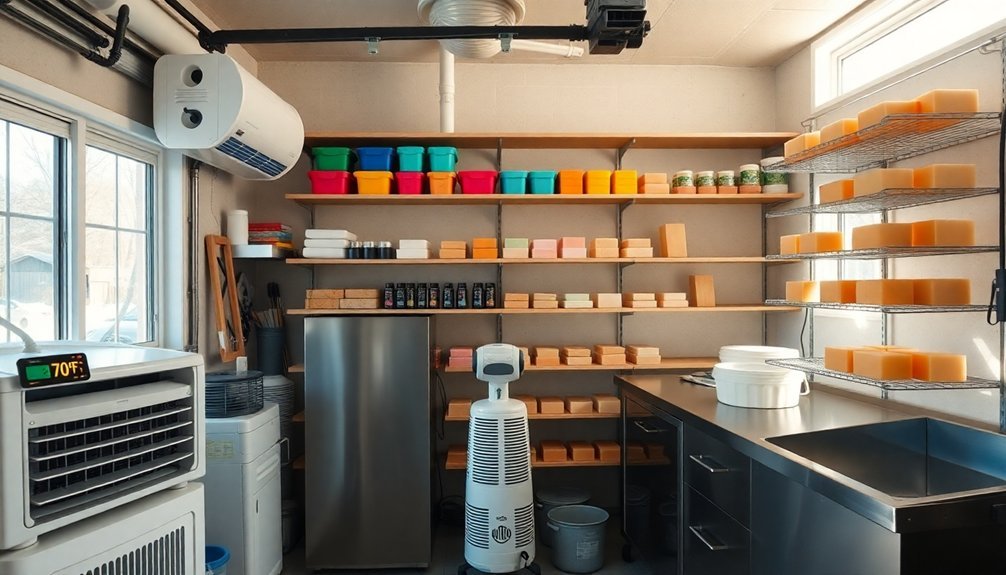
While creating beautiful handmade soap can be rewarding, maintaining proper temperatures in your garage workspace presents unique challenges throughout changing seasons.
You'll need to adapt your approach based on environmental conditions to achieve excellent results.
In colder months, insulate your workspace using cardboard and blankets around soap molds to retain heat. Soda ash formation can be significantly reduced through proper insulation, as higher internal temperatures prevent this white, powdery residue from developing on your soap.
Consider using heating pads to maintain temperatures between 120°F and 130°F for both lye and oils, promoting proper saponification and gel phase.
During warmer seasons, you might naturally achieve ideal temperatures without additional heating.
However, you'll still need to monitor conditions to prevent overheating, which can cause cracking.
Install proper ventilation for safety while ensuring your workspace remains draft-free to maintain consistent temperatures.
Always use thermometers to actively monitor both ingredients and ambient conditions.
Humidity Control Tactics for Garage Curing Spaces
Because proper humidity control greatly impacts soap curing success, you'll need to establish effective moisture management in your garage workspace.
Start by measuring your baseline relative humidity, aiming for approximately 60% RH for ideal curing conditions.
Install a dehumidifier sized appropriately for your garage space—this is your most reliable solution for consistent humidity control. For smaller spaces or as supplements, desiccants and silica gel packets can absorb excess moisture.
Implement strategic ventilation by using fans to improve air circulation and opening windows only when outdoor air is drier than inside.
Consider sealing air leaks and upgrading insulation to prevent moisture infiltration. Too much humidity can prolong curing time of cold process soap, affecting overall quality and usability. Store humidity-sensitive supplies in airtight containers and keep your curing soap in well-ventilated areas to prevent issues like glycerin sweat in melt and pour formulations.
Essential Ventilation Systems for Chemical Safety
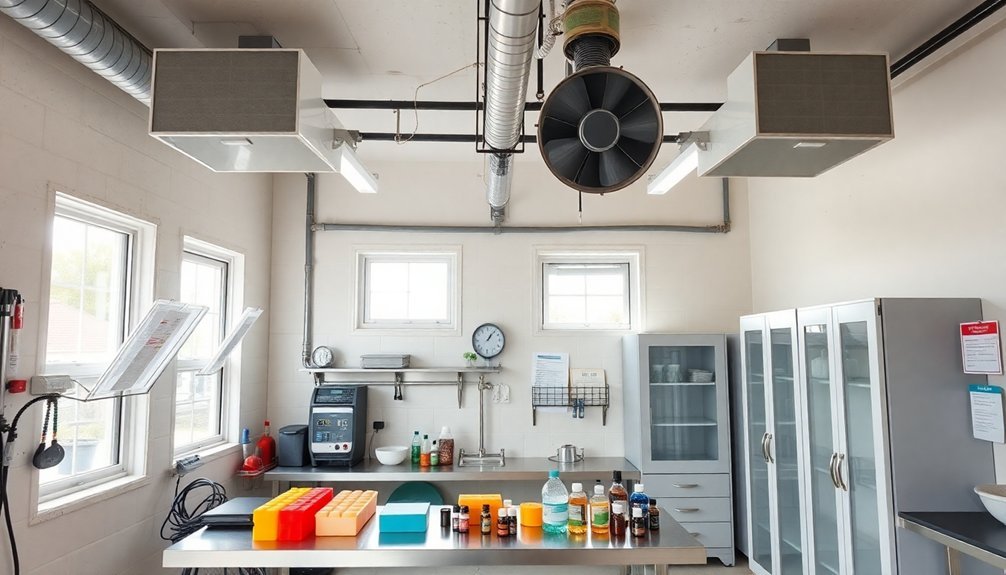
You'll need strategic exhaust fan placement in your garage workspace to effectively remove harmful lye fumes during soap making.
Position fans at lye mixing stations and curing areas to capture vapors before they spread throughout your space.
Establishing a fresh air exchange system with windows or vents on opposite sides of your garage creates cross-ventilation that continuously replaces contaminated air with clean outdoor air.
Working in a properly ventilated area is essential for reducing the inhalation risks associated with lye vapors during the saponification process.
Exhaust Fan Placement
When making soap in your garage, proper exhaust fan placement serves as the cornerstone of a safe and effective ventilation system.
Mount fans near the ceiling where they'll capture rising hot air and chemical vapors most efficiently. For wall installations, position units high up to direct airflow away from your workspace.
Ensure your fans have a clear path to external venting, eliminating potentially harmful fumes from your soap-making environment. Installing a fan with a flapper mechanism provides an airtight seal when not in use, preventing backflow of outside air.
Avoid placing fans behind shelving, equipment, or other obstructions that might restrict airflow. Create a deliberate ventilation path that pulls air from your workstation toward the exhaust points.
Consider installing fans with adjustable speeds to customize airflow based on your current project's needs.
Remember that proper placement isn't just about safety—it also contributes to your comfort while working with caustic ingredients.
Fresh Air Exchange
Fresh air exchange forms the backbone of any safe soap making operation in your garage.
You'll need a system that provides at least six air changes per hour, with more intensive ventilation if you're working with volatile or flammable ingredients like essential oils.
For most home soapmakers, a combination approach works best: install local exhaust ventilation near your mixing station to capture vapors at the source, while maintaining general ventilation throughout your garage.
Don't rely solely on passive or gravity ventilation systems—they're insufficient when handling lye and other potentially hazardous soap ingredients.
Always consult Safety Data Sheets for specific chemicals you're using, as they'll provide vital ventilation requirements.
Remember that your garage's layout affects airflow efficiency—position fans strategically to prevent stagnant air pockets where fumes could accumulate. Installing explosion-proof ventilation may be necessary if you work with highly flammable essential oils or alcohols in your recipes.
Seasonal Adjustments for Garage Soap Making
Successful garage soap making requires thoughtful adaptation to changing seasons throughout the year.
During summer months, you'll need to manage higher temperatures that alter the consistency of butters and oils. Consider reducing water content and adding sodium lactate to help soap unmold more easily in humid conditions.
In winter, your garage may require additional heating to prevent ingredients from solidifying too quickly. Adjust your recipes seasonally—create harder bars for humid seasons and softer formulations for dry periods.
Year-round, maintain proper airflow with fans and dehumidifiers to control moisture levels in your curing area. The ideal temperature for curing should be maintained between 60-80°F for optimal results.
Weigh your soap regularly to monitor water loss during curing. By anticipating seasonal changes and adjusting your approach accordingly, you'll maintain consistent quality regardless of external conditions.
Equipment Selection for Variable Climate Conditions
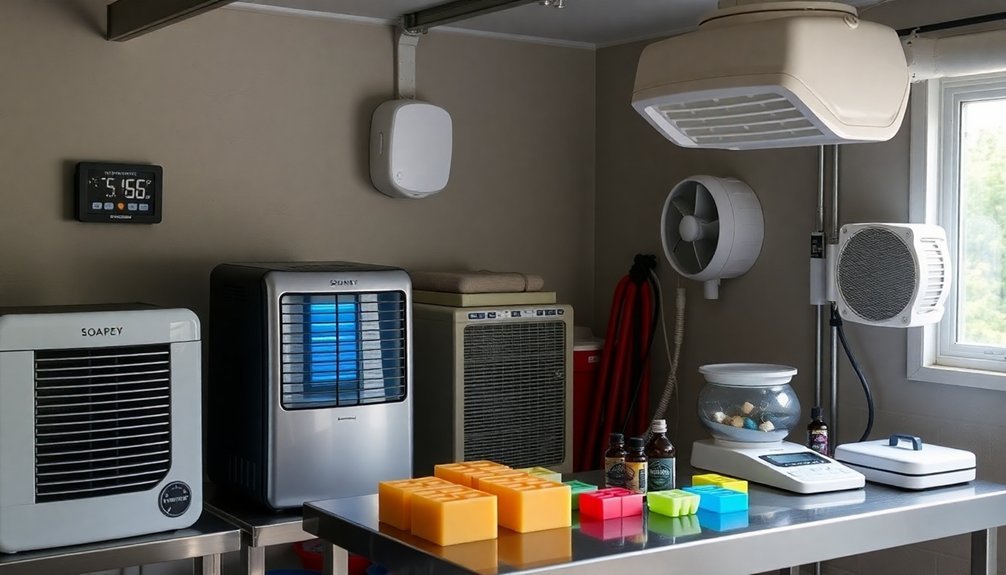
Adapting to seasonal variations becomes considerably easier with the right climate control equipment in your soap-making garage. You'll need to select tools that address temperature, humidity, and air quality—the three vital climate factors affecting soap production. Split system HVAC units are particularly ideal for garage soap-making operations due to their efficiency and space-saving design.
| Climate Challenge | Essential Equipment | Benefit |
|---|---|---|
| Temperature Fluctuations | Programmable Thermostats | Maintains consistent curing temperature |
| Humidity Issues | Dehumidifiers/Humidifiers | Prevents moisture-related defects |
| Air Quality Concerns | Fume Extraction Systems | Removes harmful vapors and odors |
For extreme climates, consider specialized solutions like insulation materials and climate-controlled workstations. Temperature control systems are non-negotiable investments, while humidity regulators become significant in particularly dry or humid regions. Don't overlook environmental monitoring tools like hygrometers and air quality sensors—they'll help you track conditions and make adjustments before problems affect your soap.
Creating Micro-Climate Zones in Your Garage Workshop
While a complete climate control system provides overall stability, dividing your soap-making garage into strategic micro-climate zones can dramatically improve production quality and efficiency.
By analyzing your garage's exposure to sunlight, wind patterns, and natural temperature variations, you'll identify ideal areas for different soap-making stages. Implementing independent temperature controls for each zone will allow precise climate management tailored to specific soap-making processes.
- Position curing racks in areas with consistent temperature and lower humidity to prevent sweating.
- Create a dedicated mixing station in the most temperature-stable zone for reliable saponification.
- Establish a cooling area away from direct sunlight and heat sources for controlled setting.
- Design a storage zone with minimal temperature fluctuations to extend ingredient shelf life.
Use modular shelving and movable workstations to adapt your zones seasonally, and consider adding plants strategically to help regulate humidity levels naturally.
Monitoring and Maintaining Ideal Environmental Parameters
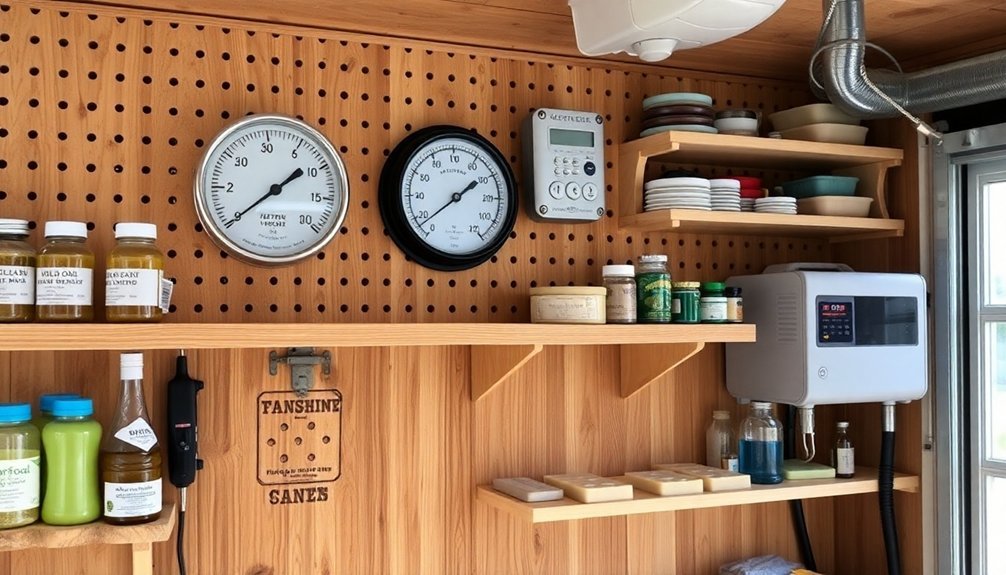
Creating micro-climate zones serves as a foundation, but actively monitoring and maintaining specific environmental parameters takes your soap making to professional quality. You'll need to track temperature, humidity, ventilation, and light exposure consistently throughout the process.
| Parameter | Ideal Condition | Monitoring Method |
|---|---|---|
| Temperature | Room temperature | Digital thermometer |
| Humidity | 40-60% | Hygrometer |
| Ventilation | Constant airflow | Fans, open windows |
| Light | Well-lit workspace | UV-resistant storage |
| Noise | Minimal | Morning scheduling |
Keep your soap at room temperature during production to facilitate proper saponification. Monitor humidity levels with a hygrometer—high humidity slows curing while low humidity speeds it up. Guarantee adequate ventilation to remove lye fumes safely. Maintaining room temperature supports the low-temperature saponification process that makes handmade soap production so energy efficient compared to commercial methods. While working in good light, store finished soaps away from direct sunlight to prevent discoloration and oxidation.
Frequently Asked Questions
How Does Altitude Affect Soap Curing Times and Procedures?
At higher altitudes, your soap will cure faster due to increased evaporation rates. You'll need to monitor weight loss closely, potentially use less water in formulations, and maintain good airflow for ideal results.
Can Solar Power Effectively Regulate Garage Temperature for Soap Making?
Solar power can help regulate your garage temperature for soap making, but you'll need backup systems for cloudy days. It works best when combined with proper insulation, fans, and thermostats for consistent conditions.
What Insulation Materials Work Best for Soap Curing Shelves?
For soap curing shelves, you'll get best results using bamboo racks with extruded polystyrene foam underneath. Add cardboard and blankets for extra insulation, especially in colder environments. Bamboo provides ideal airflow while maintaining temperature.
How Do Different Water Sources Impact Soap Quality in Garage Environments?
In your garage workshop, water quality greatly impacts soap outcomes. You'll notice hard tap water reduces lather and creates soap scum, while distilled water produces consistent results. Consider using chelators like EDTA when tap water's unavoidable.
Are Smart Home Systems Useful for Monitoring Soap Curing Conditions?
Yes, smart home systems are extremely useful for your soap curing. You'll benefit from precise temperature and humidity monitoring, real-time alerts, and remote access—ensuring ideal conditions without constant manual checks of your curing soaps.
In Summary
You've now gained the knowledge to master your garage's climate for soap making success. By controlling temperature, managing humidity, ensuring proper ventilation, and making seasonal adjustments, you'll create consistent, quality soap year-round. With the right equipment and monitoring systems, your garage workshop becomes a professional production space despite external weather challenges. Don't let climate variables affect your craft—take control and watch your soap making flourish.

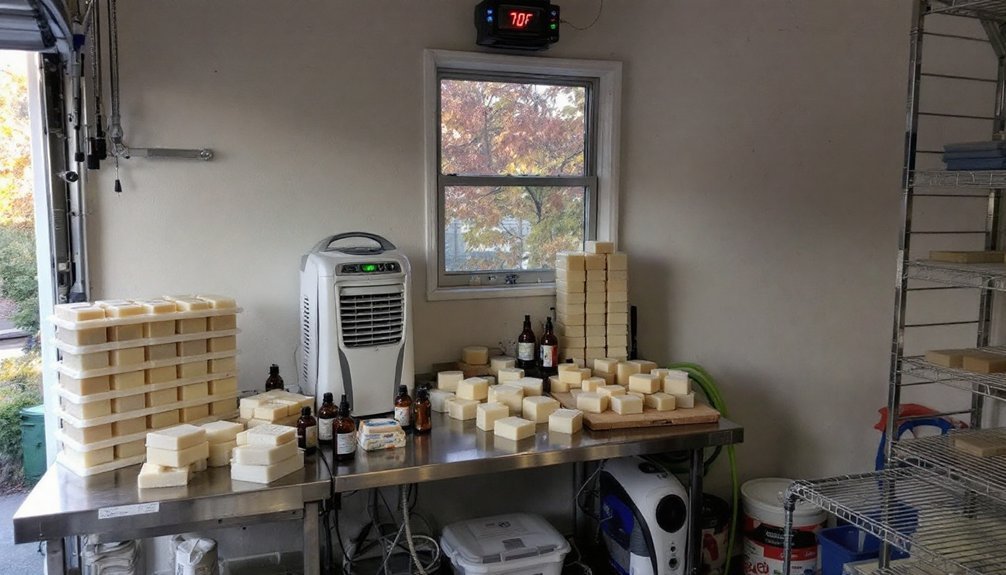



Leave a Reply